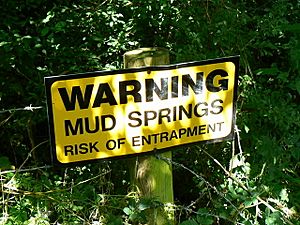Wootton Bassett Mud Spring facts for kids
The Wootton Bassett Mud Spring is a very special natural area in Wiltshire, England. It's known as a geological Site of Special Scientific Interest because of its unique mud springs. This means it's a protected place due to its important rocks and landforms. It was officially recognized in 1997. You can find it after a short walk from the canal car park, near the Wilts & Berks Canal.
Contents
What are Mud Springs?
The mud springs at Wootton Bassett are places where cold, grey mud slowly bubbles up from deep underground. This mud pushes through a thin layer of plants on the surface. The water in the mud comes from a hidden layer of rock called an aquifer. This aquifer is found beneath a type of clay called Ampthill Clay.
Amazing Fossils from Deep Below
As the mud comes to the surface, it brings with it shiny, colorful fossils. These fossils are very old, dating back to the Late Jurassic period. That's millions of years ago! The fossils are tiny sea creatures like foraminifera and ostracoda. Sometimes, they are even covered in a special mineral called aragonite. These fossils are incredibly well-preserved, meaning they look almost as good as new. Scientists have also found many tiny fish ear bones, called otoliths, here.
How the Mud Springs Behave
Usually, the mud springs just slowly ooze out mud. But sometimes, they can be quite active!
Surprising Mud Jets
In 1974, workers were cleaning a nearby stream called Hancock's Water. They were amazed to see a jet of mud shoot up into the air from one of the springs! It was a very unusual sight.
Trying to Stop the Flow
Later, in 1990, people tried to fill in the most active spring. They put about 100 tonnes of rubble, which is a lot of rocks and debris, into it. But the mud was too strong! It just pushed the rubble aside and flowed into Hancock's Water. The rubble quickly disappeared into the spring.
Studying the Mud Springs
Scientists are very interested in the Wootton Bassett Mud Springs. They want to learn more about what's happening deep underground.
Exploring Deep Earth Life
In 1996, a group of scientists from the British Microbiological Biodiversity Association (BMBA) visited the springs. They wanted to study the tiny living things, called microbes, that live in the mud. These microbes can live without oxygen, which is called being anaerobic. The scientists wondered if these mud springs were connected to a "deep terrestrial biosphere." This is a fancy way of saying a hidden world of life deep inside the Earth.
The scientists found that the springs are very deep, more than 120 meters (about 400 feet) down! They are also about 75 millimeters (about 3 inches) wide. The springs constantly release several cubic meters of mud every day. The scientists also measured the temperature, how acidic or basic the fluid was (its pH), and how well it could conduct electricity. They found five main areas where mud springs were active, with one area having three separate springs.


